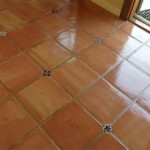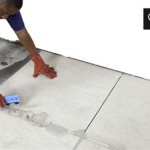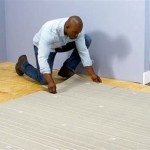Can You Put Hardwood Over Asbestos Tile? A Comprehensive Guide
The prospect of installing new flooring often coincides with the discovery of existing asbestos-containing materials (ACM), most commonly in the form of floor tiles. Given the health risks associated with disturbing asbestos, homeowners frequently inquire about the possibility of covering asbestos tile with hardwood flooring instead of undertaking a potentially hazardous removal process. This article provides a detailed examination of the factors to consider when deciding whether to install hardwood over asbestos tile, outlining the potential benefits, risks, and necessary precautions.
Asbestos was widely used in building materials throughout much of the 20th century due to its fire-resistant and insulating properties. Floor tiles, particularly those manufactured before the 1980s, are a common source of asbestos in older homes. These tiles typically contain a relatively low percentage of asbestos fibers, but they pose a potential health hazard if they are damaged, broken, or disturbed during removal or renovation.
Leaving asbestos tile in place and covering it is generally considered a safer approach than attempting removal, provided certain conditions are met and proper installation techniques are employed. The primary objective is to encapsulate the asbestos, preventing the release of fibers into the air. However, a thorough assessment is crucial to determine the suitability of this approach.
Key Considerations Before Installing Hardwood Over Asbestos Tile
Several crucial factors must be evaluated before proceeding with hardwood installation over existing asbestos tile. These considerations aim to determine the overall safety and feasibility of the project.
Condition of the Existing Tile: The condition of the asbestos tile is paramount. The tiles must be intact, securely adhered to the subfloor, and free from significant damage, cracking, or crumbling. If the tiles are loose, broken, or deteriorating, encapsulation may not be a viable option. Loose tiles pose a risk of fiber release even with encapsulation, and damaged tiles may make a level and stable surface for hardwood installation impossible. In such cases, abatement by a licensed professional is often necessary.
Subfloor Integrity: The subfloor underlying the asbestos tile must be structurally sound and capable of supporting the additional weight of the hardwood flooring. Any signs of water damage, rot, or instability should be addressed before proceeding. A weak or damaged subfloor can compromise the integrity of the entire flooring system, potentially leading to issues such as unevenness, squeaking, and premature wear. Reinforcement or repair of the subfloor may be required prior to installation.
Height Considerations: Adding hardwood flooring over existing asbestos tile will raise the floor level. This can potentially create issues with doorways, transitions to other rooms, and appliance clearances. It is crucial to carefully measure the existing floor height and calculate the additional height that the hardwood flooring will add. Consider whether doors will need to be trimmed, or if transitions to adjacent flooring will require ramps or adaptations. Failure to account for height differences can lead to tripping hazards and aesthetic inconsistencies.
Legal and Regulatory Requirements: Federal, state, and local regulations regarding asbestos-containing materials vary significantly. It is essential to consult with local authorities or environmental agencies to determine whether any permits or specific procedures are required for covering asbestos tile. Some jurisdictions may require that a building inspection be conducted prior to any renovation work that involves asbestos. Compliance with all applicable regulations is crucial to avoid potential fines or legal liabilities. Furthermore, disclosing the presence of asbestos to future homebuyers is typically a legal requirement.
Professional Assessment: It is strongly recommended to engage a qualified asbestos inspector or environmental consultant to conduct a thorough assessment of the asbestos tile. This assessment should include visual inspection, sampling, and laboratory analysis to confirm the presence of asbestos and evaluate the condition of the tiles. The inspector can also provide guidance on the best course of action based on the specific circumstances of the project. Their expertise can help ensure that the project is carried out safely and in compliance with all applicable regulations. Attempting to handle asbestos without professional guidance can expose individuals to unnecessary health risks and potential legal repercussions.
Installation Procedures and Precautions
If, after a thorough assessment, installing hardwood over asbestos tile is deemed a viable option, specific installation procedures and precautions must be followed to minimize the risk of asbestos fiber release.
Surface Preparation: The existing asbestos tile surface must be properly prepared to ensure adequate adhesion of the new flooring. This typically involves cleaning the tiles thoroughly to remove any dirt, grease, or debris. A bonding agent or primer specifically designed for use over non-porous surfaces may be required to improve adhesion. Consult with the manufacturer of the adhesive or underlayment being used to determine the appropriate surface preparation methods.
Underlayment Installation: An underlayment is crucial for providing a smooth and level surface for the hardwood flooring and further encapsulating the asbestos tile. Choose an underlayment with a high density and moisture resistance to prevent any potential migration of asbestos fibers. Ensure the underlayment is properly secured to the underlying asbestos tile using adhesives and fasteners that are compatible with both materials. Follow the manufacturer's recommendations for installation procedures and fastener spacing.
Adhesive Selection: The adhesive used to secure the hardwood flooring to the underlayment must be carefully selected to ensure compatibility and long-term performance. Choose an adhesive that is specifically designed for use over non-porous surfaces and that provides a strong bond. Consider using a low-VOC (volatile organic compound) adhesive to minimize indoor air pollution. Apply the adhesive according to the manufacturer's instructions, paying close attention to coverage and drying time.
Cutting and Fitting: When cutting hardwood flooring to fit around walls and other obstructions, use tools that minimize dust generation. A wet saw or a dust-collection system can help prevent the release of asbestos fibers. Avoid sanding or grinding the asbestos tile directly, as this can create airborne dust that contains asbestos. Ensure adequate ventilation in the work area and wear appropriate personal protective equipment (PPE), such as a respirator, gloves, and eye protection.
Seam Sealing: Sealing the seams between hardwood planks can help prevent moisture from penetrating to the asbestos tile below. Use a high-quality sealant that is compatible with the hardwood flooring and the adhesive. Apply the sealant according to the manufacturer's instructions, ensuring that all seams are completely sealed.
Potential Problems and Long-Term Monitoring
While covering asbestos tile with hardwood can be a viable option, it is not without potential drawbacks. Long-term monitoring and maintenance are essential to ensure the continued safety and integrity of the encapsulation.
Moisture Damage: Moisture intrusion is a significant concern when covering asbestos tile. If moisture penetrates through the hardwood flooring and underlayment, it can potentially damage the asbestos tile and cause the release of fibers. Take steps to prevent moisture exposure, such as using a vapor barrier, selecting moisture-resistant flooring materials, and addressing any potential sources of leaks or condensation.
Accidental Damage: Activities such as drilling, nailing, or removing flooring in the future can potentially disturb the asbestos tile and release fibers. Clearly mark the location of the asbestos tile and inform future contractors or homeowners of its presence. Take precautions to avoid any activities that could damage the asbestos tile, and if damage does occur, consult with a qualified asbestos abatement professional.
Delamination or Separation: Over time, the adhesive bond between the hardwood flooring, underlayment, and asbestos tile may weaken, leading to delamination or separation. This can create an uneven surface and potentially expose the asbestos tile. Regularly inspect the flooring for any signs of delamination or separation, and address any issues promptly to prevent further damage.
Future Renovations: If future renovations are planned, carefully consider how the presence of asbestos tile will impact those projects. Removal of the hardwood flooring could potentially disturb the asbestos tile and require professional abatement. It is essential to plan ahead and take appropriate precautions to minimize the risk of asbestos fiber release.
Regular Inspections: Conduct regular visual inspections of the hardwood floor for any signs of damage, wear, or moisture intrusion. Address any issues promptly to prevent further deterioration of the flooring system. Keep records of all inspections and maintenance activities.
Ultimately, the decision of whether to install hardwood over asbestos tile should be based on a comprehensive assessment of the specific site conditions, applicable regulations, and the homeowner's risk tolerance. Consulting with qualified professionals and following recommended procedures are essential to ensure the safety and long-term success of the project.

Installing Hardwood Over Asbestos Tiles Homeadvisor

How To Install Hardwood Flooring Over Asbestos Tiles 123

How To Install Tile Over Asbestos Ehow

Can I Put A New Floor Over Asbestos Tiles Branch Environmental

Flooring That Can Be Installed Over Asbestos Tile

How To Seal Asbestos Tiles Hunker

How To Waterproof A Basement

How Can I Easily Safely And Ly Cover Asbestos Flooring

Asbestos Floor Tiles 101 What To Know About This Old Home Hazard Bob Vila

Is It Epa Acceptable To Cover Asbestos Tiles With Hometalk
Related Posts








